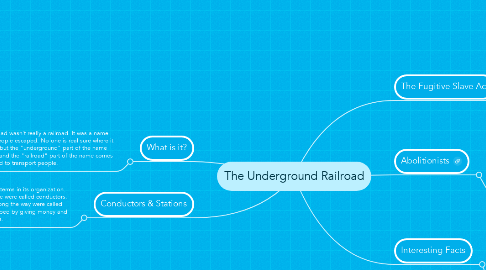The Underground Railroad
by Valerie Rodriguez


1. What is it?
1.1. The Underground Railroad wasn't really a railroad. It was a name given to the way that people escaped. No one is real sure where it originally got its name, but the "underground" part of the name comes from its secrecy and the "railroad" part of the name comes from the way it was used to transport people.
2. The Fugitive Slave Act
2.1. In 1850 the Fugitive Slave Act was passed in the United States. This made it a law that runaway slaves found in free states had to be returned to their owners in the south. This made it even more difficult for the Underground Railroad. Now slaves needed to be transported all the way to Canada in order to be safe from being captured again.
3. Conductors & Stations
3.1. The Underground Railroad used railroad terms in its organization. People who led the slaves along the route were called conductors. Hideouts and homes where slaves hid along the way were called stations or depots. Even people who helped by giving money and food were sometimes called stockholders.
4. Abolitionists
4.1. Abolitionists were people who thought slavery should be made illegal and all current slaves should be set free. The abolitionist movement started with the Quakers in the 17th century who felt that slavery was un-Christian. The state of Pennsylvania was the first state to abolish slavery in 1780.
5. Interesting Facts
5.1. Slave owners really wanted Harriet Tubman, a famous conductor for the railroad, arrested. They offered a reward of $40,000 for her capture.The most common route for people to escape was north into the northern United States or Canada, but some slaves in the deep south escaped to Mexico or Florida. Canada was often called the "Promised Land" by slaves. The Mississippi River was called the "River Jordon" from the Bible. In keeping with the railroad terminology, escaping slaves were often referred to as passengers or cargo.
5.1.1. Schedule
5.1.2. Budget

